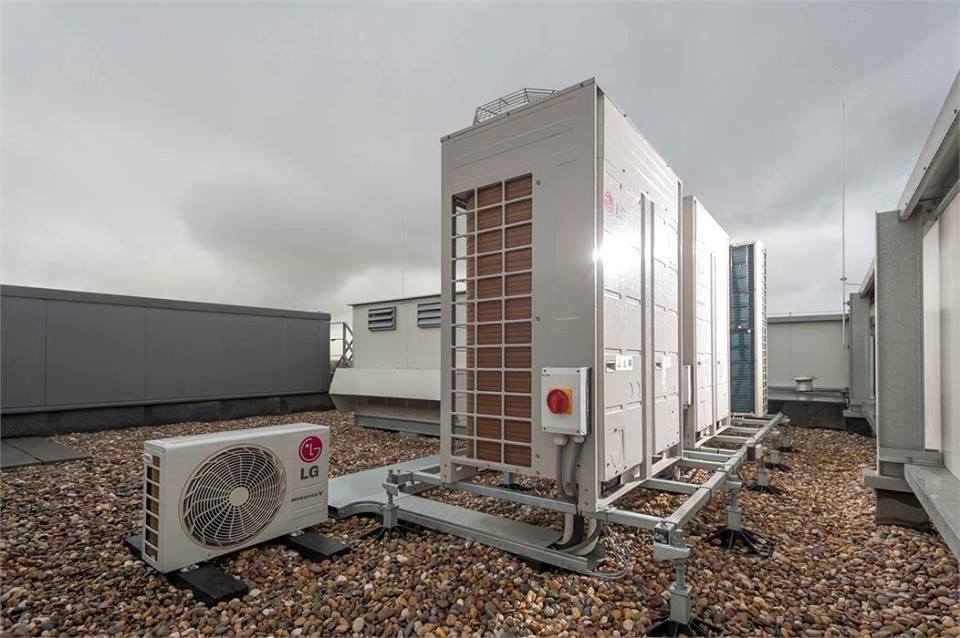What is the VRF system?
Variable refrigerant flow (VRF) is an air-condition system configuration where there are one outdoor condensing unit and multiple indoor units. The term variable refrigerant flow refers to the ability of the system to control the amount of refrigerant flowing to the multiple evaporators (indoor units), enabling the use of many evaporators of differing capacities and configurations connected to a single condensing unit. The arrangement provides an individualized comfort control and simultaneous heating and cooling in different zones. With a higher efficiency and increased controllability, the VRF system can help achieve a sustainable design.
The VRF technology uses an inverter-driven scroll compressor and permits up to 60 indoor units to operate from one outdoor unit (varies from manufacturer to manufacturer). The inverter scroll compressors are capable of changing the speed to follow the variations in the total cooling/heating load as determined by the suction gas pressure measured on the condensing unit.

What is the difference between VRF system and the Multi-split system?
VRF system is similar to the multi-split system which connects one outdoor unit to multiple evaporators (indoor units). However, multi-split systems turn OFF or ON completely in response to one master controller, whereas VRF systems continually adjust the flow of refrigerant to each indoor evaporator. The control is achieved by continually varying the flow of refrigerant through a pulse modulating valve (PMV) whose opening is determined by the microprocessor receiving information from the thermistor sensors in each indoor unit. The indoor units are linked by a control wire to the outdoor unit which response to the demand from the indoor units by varying its

compressor speed to match the total cooling and/or heating requirements.
What are the types of VRF system?
There are two types of VRF system; Heat pump (two pipes) system & Heat recovery (three pipes) system.
- Heat pump (two pipes) system permit heating or cooling in all of the indoor units but not simultaneous heating and cooling. When the indoor units are in the cooling mode, they act as evaporators; when they are in the heating mode, they act as condensers.
- Heat Recovery (three pipes) system have the ability to simultaneously heat certain zones while cooling others; each manufacturer has its own proprietary design (2-pipe or 3-pipe system), but most use a three-pipe system (liquid line, a hot gas line and a suction line) and special valving arrangements. In this case, the heat extracted from zones requiring cooling is put to use in the zones requiring heating. This is made possible because the heating unit is functioning as a condenser, providing sub-cooled liquid back into the line that is being used for cooling. While the heat recovery system has a greater initial cost, it allows for better zoned thermal control of a building and overall greater efficiencies.
What are the advantages of VRF system?
- Energy Efficiency. VRF system uses less energy for several reasons. The system is designed to provide exactly the amount of cooling needed for the current conditions, which means it runs less frequently and at a lower capacity. The VRF system is also designed to capture heat from the cooling process and reuse it in other zones that may need heating.
- Quiet Operation. In a VRF system, the noisier condensing unit is typically outside, and the indoor air handlers are smaller and quieter than a traditional split system.
- Heat And CoolSimultaneously.The VRF system captures residual heat absorbed from the air during the cooling process and redirects that heat to other parts of the building that need heat.
- Consistent Comfort.The VRF system’s compressor can detect the precise requirements of each zone, and send the precise amount of refrigerant needed to do the job. As a result, each area of your space is consistently comfortable with well-controlled humidity and no hot or cold spots.
- Less Downtime.Since the VRF system is designed to run only when needed and under partial load conditions, there is less wear and tear on the parts. That means fewer breakdowns. Also, if something goes wrong with one indoor unit, often the others are unaffected. That means your whole space won’t be without air conditioning all at once.
- Requires Less Space. VRF system doesn’t usually require ducts, they don’t require as much wall and ceiling space for the equipment.
- Modern Controls.For residences, you can take advantage of mobile control technology that lets you adjust temperature settings for each zone from your mobile device. For commercial settings, the VRF system’s built-in controls may allow you to skip purchasing expensive building management software.
What are the issues to be considered when choosing the VRF system?
- Higher Up-Front Cost.VRF system may cost more than traditional central air systems up front. But this cost can be offset by lower energy bills and repair expenses over time.
- Limitation of Refrigerant Piping. Each manufacturer specifies both the size of the pipework required for their system and the maximum permissible vertical and total refrigerant pipework runs.
- Compliance with ANSI/ASHRAE Standard 15-2001. VRF system must comply with ASHRAE Standard 15-2011 – Safety Standard for Refrigeration Systems (ANSI approved). ASHRAE Standard 15-2001 guides designers on how to apply a refrigeration system in a safe manner and provides information on the type and amount of refrigerant allowed in an occupied space.
- Requires An Experienced Installer.These systems are extremely sophisticated and require a trained and experienced installer. If you choose a company that doesn’t understand the unique requirements of VRF system, you’ll end up with sub-par performance and you’ll pay more, in the end, to have an expert come in to fix it.
“VRF system provides an alternative realistic choice to traditional central systems. It captures many of the features of chilled water systems while incorporating the simplicity of DX systems.”

